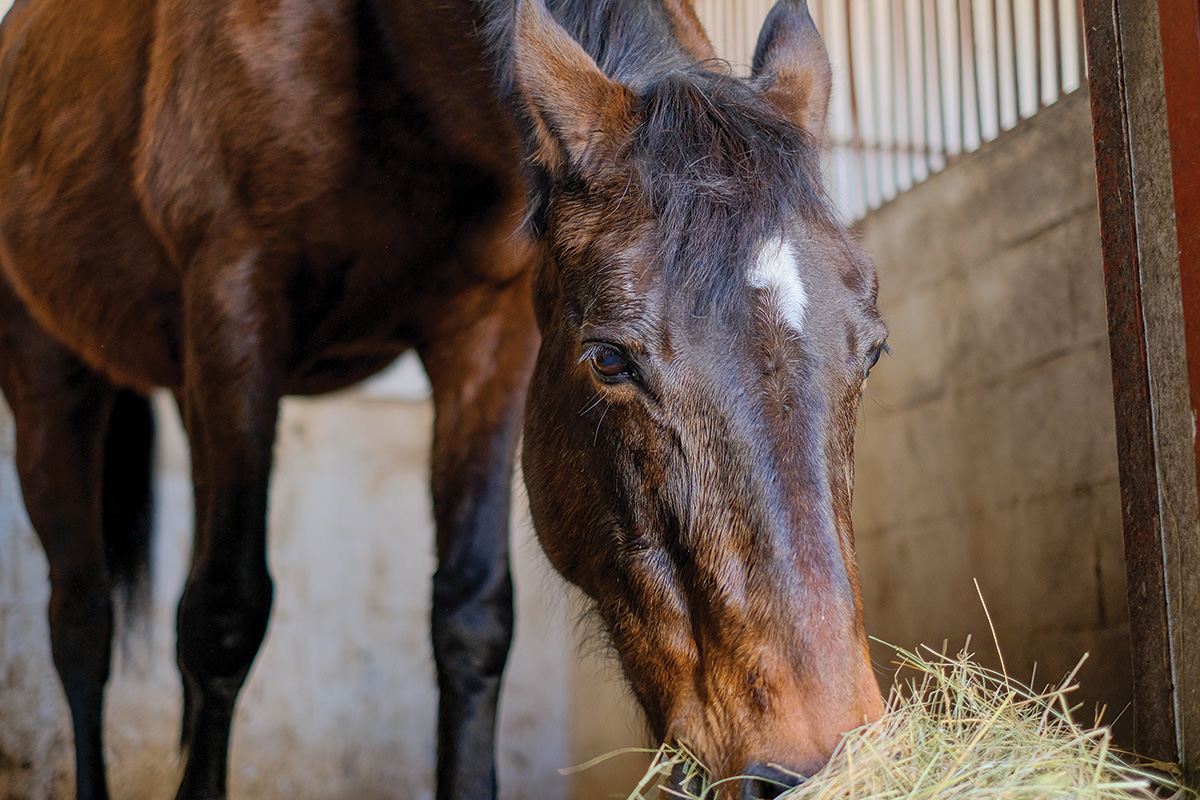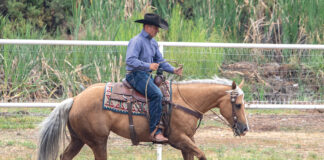Read Vet Adventures: High-Altitude Rescue, Part 1 for the first installment of Doreen’s story.

I’d seen many horses with her type of injury that coped just fine, and since Doreen’s head never came out of the feeder, it was several days before we noticed that there was a problem.
Eating Troubles
One of the ranch hands, a woman named Michelle, haltered the emaciated mare. Doreen was indignant at being removed from her meal and tried to bite both of us. Michelle offered her a handful of hay and I could see that Doreen’s jaw and tongue were working normally as she chewed. But then a big green wad dropped out of her mouth.
She managed to get the lost hay back into her mouth and eventually swallowed most of it. My heart hurt as I remembered the weakened animal trying to access what little hay they’d been fed at the previous property. The stronger horses continually drove her away, and the owner of the so-called horse rescue had done nothing to help her. The mare surely would have starved to death had the sheriff not intervened.
Doreen was moved to a bright, roomy stall with fluffy pine shavings, an automatic waterer, and brand-new salt and mineral blocks. She celebrated by cleverly biting me as I listened to her heart and lungs. I shooed her nipping mouth away but didn’t have the heart to correct her.
Her pelvic bones jutted painfully, and her spine protruded from her coarse winter coat. I felt a familiar surge of anger toward the humans who had utterly failed Doreen. Maybe I needed to go bite someone, too.
Do the Mash
Michelle busied herself making Doreen’s first small mash, running the water in the big utility sink until it was nice and warm and adding it to pelleted feed. When horses have been starved, it’s important not to overfeed them, or they can become very ill.
Since Doreen had had access to food, she would be fed a little differently than if she’d had no food, but it would still be a slow and careful process. We used pelleted timothy hay in our mashes, and over time, would add in an easily digested ration.
The mash had to soak until it was softened, and Doreen, who was clearly tired of biting everyone, stood listlessly in her stall, her head hung low and a hopeless look in her eye. I stroked her shoulder and told her that food was on the way, and we were going to take care of her.
I don’t know if everyone else talks to horses as though they understand every word we say, but I’ve done it for my whole life. Doreen pinned her ears slightly at my voice, but otherwise ignored me.
Michelle lugged the steaming bucket in and tipped it into a large rubber feed tub. Doreen sniffed at it, then backed away in surprise, licking her lips. We’d made sure the ration wasn’t too hot for her, but Doreen wasn’t used to heated food.
She tried curling her upper lip into the air, but couldn’t quite manage it because of the nerve damage. She snorted indignantly at the rubber bucket and pawed the ground, then quickly nipped at Michelle’s arm again.
Michelle scooped a little mash into a small pan and offered it to Doreen. “If you want to bite something, try this!”
Doreen backed up a few more steps, then bravely sampled the mash. She mouthed it, and I saw her swallow. She went for more but dropped the second mouthful.
I nudged the tub on the floor, and this time she lunged at the mash with her mouth wide open. I reflexively tucked my arms inside the sleeves of my thick coat and moved aside. As Doreen chewed in delight, she lifted her head and looked directly at Michelle and I, and there was unmistakable relief and joy on the hungry mare’s face.
We hunkered down in the corner and thoroughly enjoyed watching Doreen eat her first mash. The mare dropped wet gobs of food all over the stall floor, but she eventually cleaned everything up and looked around eagerly for more. It was hard not to want to refill her tub, but we had to let her adapt to the new food, and it was critical to do so slowly. There was some fresh hay piled in the corner for her, and she’d get another small mash in six hours.
Next Steps for Doreen
As the days passed, Doreen got better and better at keeping the food in her mouth, and she bit us less and less. She learned to eat over the tub, so if she dropped food, she could easily recover it. After each meal, her feed tub was licked clean.
Her mashes increased in size and frequency. She was starting to gain weight and show an interest in her surroundings. We also realized how untrained she was, and I suspected that she’d been a victim of a program where people accept cash from the Bureau of Land Management (BLM) to adopt a Mustang, then promptly dump them at a sale lot. (Just in case your faith in humanity hasn’t already been tested enough today.)
Since we knew that the young mare was able to gain weight, the next step was determining whether the nerve damage to her face would be permanent. And the bigger issue was finding a permanent and stable home for Doreen, but who would want to take on a young horse that could only eat soft mashes?
The sensible thing to do was probably to euthanize her if she wasn’t able to recover, but I balked at the thought of snuffing out this mare’s life. She wanted to live, and we wanted to be able to give her a way to do that.
To be continued …
This installment of Doreen’s story within Vet Adventures appeared in the May 2023 issue of Horse Illustrated magazine. Click here to subscribe!





